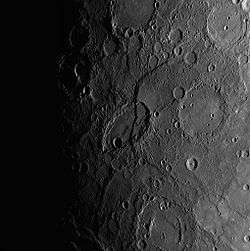Beagle Rupes
 | |
| Feature type | Rupes |
|---|---|
| Coordinates | 1°54′S 258°53′W / 1.9°S 258.89°W[1]Coordinates: 1°54′S 258°53′W / 1.9°S 258.89°W[1] |
| Eponym | HMS Beagle[1] |
Beagle Rupes is an escarpment on Mercury, one of the highest and longest yet seen.[1] It was discovered in 2008 when MESSENGER made its first flyby of the planet. It has an arcuate shape and is about 600 km long. The scarp is a surface manifestation of a thrust fault, which formed when the planet contracted as its interior cooled.[2]
Beagle Rupes consists of three segments. The central segment trends in the north–south direction and crosscuts the elliptically shaped Sveinsdóttir crater. The dimensions of the latter are 220 × 120 km. The floor of Sveinsdóttir was flooded by the smooth plains material and deformed by wrinkle-ridges before the appearance of Beagle Rupes. The maximum relief within the crater is about 0.8 km. To the south of Sveinsdóttir the scarp turns to the south–east. A 27 km diameter crater is superposed on this segment. To the north of Sveinsdóttir the scarp turns to north–east completing a large arc. This segment of Beagle Rupes crosscuts and deforms a small 17 km diameter crater. The relief in this places reaches 1.5 km. The scarp appears to be a young feature, which postdates the emplacement of the smooth plans and formation of the majority of impact craters.[2]
Beagle Rupes is named after HMS Beagle, a ship made famous through association with Charles Darwin.[1]
References
- 1 2 3 4 5 "Beagle Rupes". USGS. Retrieved July 18, 2010.
- 1 2 Watters, Thomas R.; Solomon, Sean C.; Robinson, Mark S.; et al. (2009). "The tectonics of Mercury: The view after MESSENGER's first flyby". Earth and Planetary Science Letters. 285 (3-4): 283–296. Bibcode:2009E&PSL.285..283W. doi:10.1016/j.epsl.2009.01.025.

